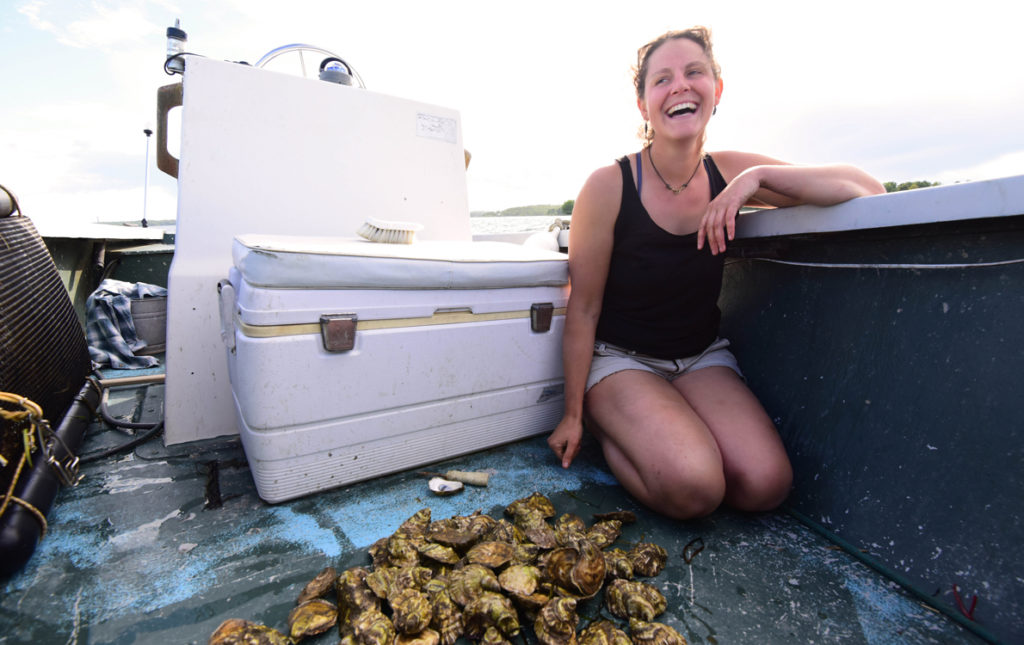By Kelli Park
Emily Selinger has made it her mission to change the way we look at oysters, one farm-share at a time.
Selinger spent her childhood on the Harraseeket River in Freeport, where she fell in love with working on the water. She taught sailing classes at a young age, and pursued her interest in boats by getting her captain’s license and working on schooners up and down the East Coast.
She studied art history in college in Washington and, for six years, on and off, worked on a 140-foot schooner that cruised between Boston and St. Croix.
“I learned a lot on the water in that boat, mostly about myself,” Selinger says. She eventually returned to Maine and work on a lobster boat. She also befriended Amanda Moeser, owner of Lanes Island Oyster Co. in Yarmouth, which inspired her to start a similar business.
“I was totally captivated with oyster farming from the start,” Selinger remembers. “It’s a perfect marriage of all my favorite things about working on the water—hands-on problem solving, physical maintenance, and I can always be improving and reinventing.”
Selinger began working with Moeser in 2017 and quickly decided to take the plunge, buying a small batch of oyster seed, which she grew on Moeser’s farm that fall, and began the process of establishing her own oyster farm.
“I can’t imagine going out and finding a place to grow oysters without the local knowledge from growing up here. Messing around in little boats, running aground, wandering around in the mud,” she says. “I knew, pretty much instantly, where I wanted to site my farm.”
She then acquired three limited purpose aquaculture licenses for her farm in Freeport, and so began what she calls “the most perfect self-employment opportunity on the water that I ever could have dreamed of.”
CLEAN AND SIMPLE
Selinger’s approach is clean and simple. She operates on 1,600 square feet in the Harraseeket River (with a pending application for expansion) using her 19-foot flat-bottomed, center console skiff, Mignonette. She prefers to work at low tide, when the water is about 2-feet deep, so she can get out and walk in her waders to do routine maintenance.
“I have everything rigged pretty simply right now because it’s just me, and it works well. I’m trying to keep things as minimal as I can,” she says.
After receiving a start-up business grant from the Libra Future Fund, she built a facility in her garage for safe handling and product storage in order to get her enhanced retail license, which is required to sell at farmers’ markets. Selling there is one of her goals for next year.
“I’m trying to approach oyster farming like a vegetable farmer,” she explains.

Selinger spent the past winter developing her strategy, channeling her creativity, and thinking like an entrepreneur.
“It just hit me one day. I was thinking about food and how people sell food and where people sell food,” she says, growing animated. “Where do you think of when you think of eating oysters? Portland. The restaurant scene. Fine dining.”
Oysters have been seen as a delicacy, but Selinger argues that with ideal growing conditions statewide, they can be produced “by the hundreds of thousands.” So why not work to have oysters understood by consumers as “an everyday, eat-at-home item?”
Selinger uses the traditional community-supported agriculture as her model, striving to eliminate the barriers between farmed food and delicacies. Instead of implementing a weekly CSA schedule, which always results in “rotting kale in the fridge,” as she says, this farm-share is individualized: customers purchase allotments of oysters and select year-round delivery dates that fit within their schedule.
Selinger also hopes to increase accessibility through face-to-face connections. She offers personal shucking lessons for first-time customers, and starter kits, which include an insulated cooler bag, shucking knives, and how-to instructions. She also plans to educate customers about different cooking methods (she recommends grilling) to push beyond the raw stereotype and appeal to a wider audience.
Since she launched the CSA earlier this year, Selinger already has 20 customers and has booked shucking gigs for weddings, corporate parties, fundraising events, and festivals in the coming months.
She looks forward to diversifying the local oyster industry while “running her own little experiments” to develop her oyster flavor profile—sweet, salty, and flowery, with a hint of citrus .
And she has strong feelings about the marine economy.
“If we want our working waterfront to continue to grow and be the vibrant community it is now, making some space for people in other ventures, such as aquaculture, is really important. It takes cooperation from everyone, on all sides. The more people we have working on the water here, the better it will be for keeping Maine the way it is. I wholly believe that.”
For more information, visit emilysoysters.com.





